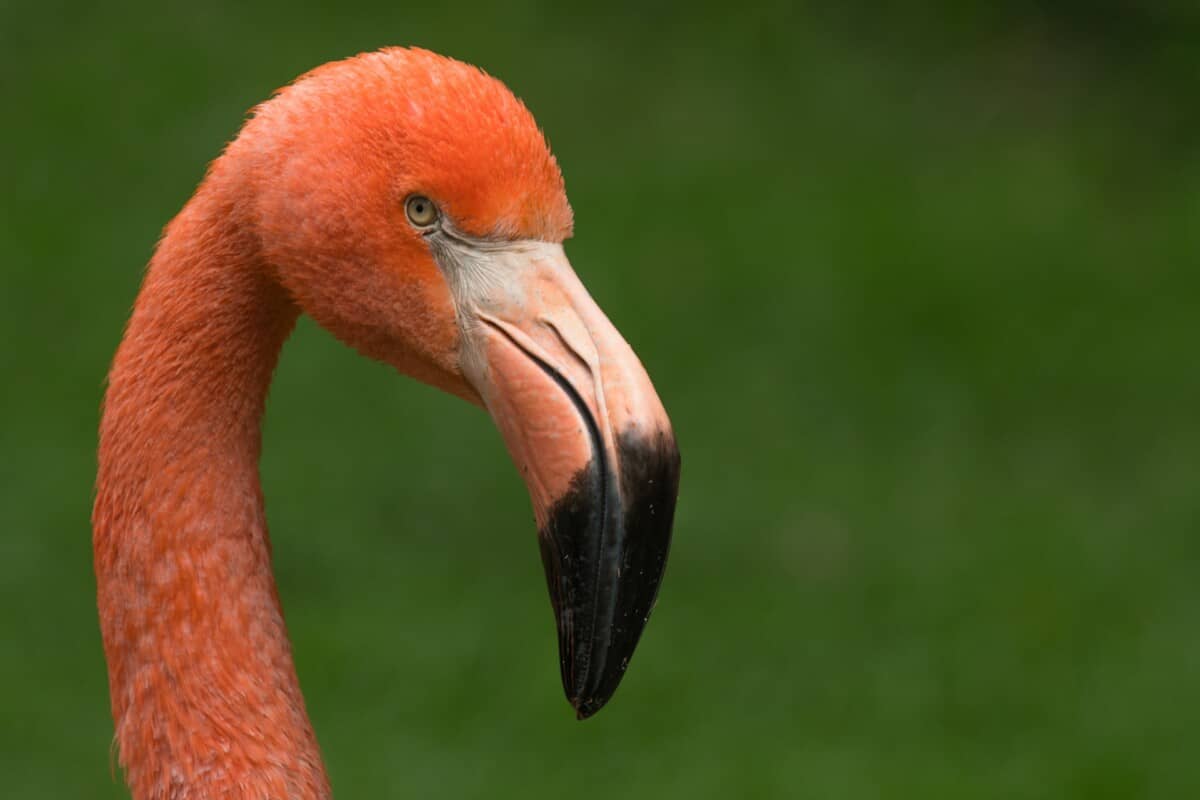Flamingo beaks have mystified scientists for over 2,000 years. I’m happy to report that scientists are gaining a good understanding of how the beak works and some of the complex structures involved.
The Flamingo’s beak is bent as an adaptation to being used upside down to filter feed on tiny plants and organisms in the water. With its long neck and long legs, the flamingo can stand in shallow water and reach the bottom where crustaceans, mollusks, and insects live in the mud. Using rows of plates lining their beaks, flamingos strain food items from the water.
While on a visit to Walvis Bay in Namibia, I had the opportunity to watch a Greater Flamingo perform a strange little dance as it stirred up shrimp and larvae living in the mud. With its head down, it would swish its strange beak around in the muddy soup at its feet. It was filter feeding!
The Flamingo beak – a remarkable adaptation
Have you ever run across a bird that is a filter feeder…!? When I think of filter feeding I think of baleen whales, like the great Blue whale and Humpback, feeding on plankton. Turns out that flamingos have a diet of tiny creatures like shrimp and other water creatures that live in and on the muddy bottom. Their long legs and long neck allow them to feed in a range of depths.
When they reach down with those long necks, flamingos actually end up feeding upside down! Consequently, these birds have undergone a series of amazing adaptations through natural selection. The fact that they feed upside down has shaped the bill into the strange, bent shape that we see today.
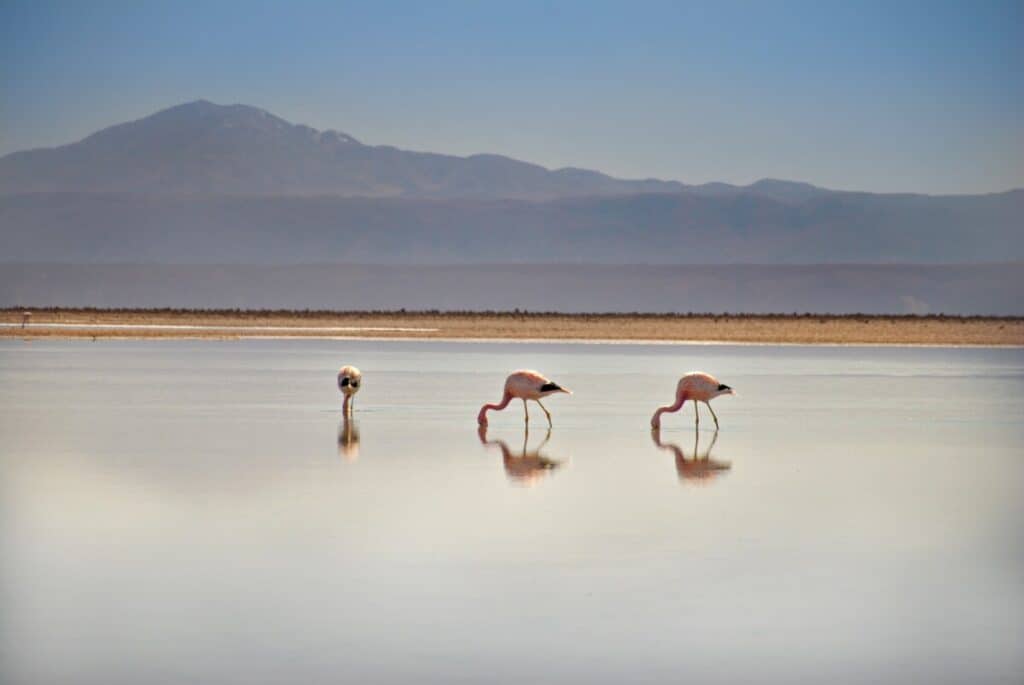
In most birds, the upper beak is larger than the lower one. Guess what happens when these birds make a living by feeding upside down? The beaks get reversed and the lower one becomes much larger and stronger. Not only that, but the articulation of the beak to the skull has evolved! The upper beak can move when feeding, and the stationary lower beak is fused to the skull. No wonder flamingos look so strange when they stand upright – the beak looks upside down. And functionally it really is upside down.
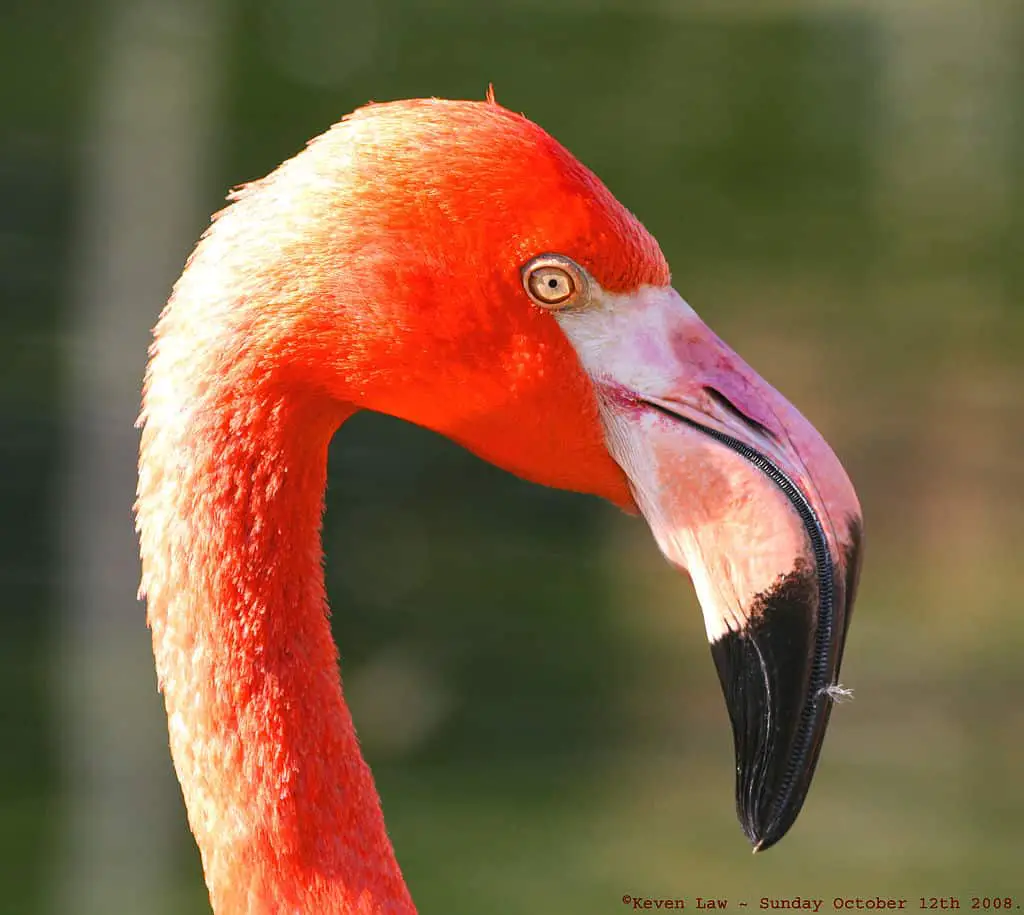
The unusually shaped bill contains plates that act like tiny filters to trap the creatures they feed upon. These plates, or lamellae, are comb-like structures covered with fine hairs and are found on both the upper and lower bill. As the flamingo feeds these hairs are raised and lowered, and they can adapt the shape to the size of the food particles.
The most amazing flamingo tongue
Flamingo tongues are also well-adapted to their filter feeding lifestyle. Using their tongues, they suck water in at the front of the bill and pump it out through the sides. The tongue sits in a deep central groove in the larger lower bill. When feeding, it sucks water into its mouth by pulling the tongue backwards. Then it pushes it tongue forward to expel the water through the lamellae which capture and filter out any living creatures suspended in the organic soup. The tongue has backward facing spines to help swallow the trapped food.
During Roman times, flamingo tongues were considered a great delicacy. Apicius, a gourmand of the day, described the tongues as having “a specially fine flavor.” The dish became popular with upper class Romans and flamingos were slaughtered by the thousands. Apparently, the rest of the bird was also considered tasty, so hopefully they ate more than just the tongues.
The more I learn about the Roman diet, the more I realize that they had a peculiar palate – according to modern tastes. They enjoyed such delicacies as pheasant brains, parrotfish livers, and lamprey guts. And the famous garum sauce, made of well-rotted fish guts, was considered an indispensable enhancement to any meal!
Flamingos Prefer Pink
You may have heard that flamingos are pink because of the carotenoids in their diet. But what are carotenoids? These are fat-soluble plant pigments found in the cells of a wide variety of plants, algae and bacteria. They help plants absorb light energy through photosynthesis. Flamingos become pink when they eat the right foods – brine shrimp, for example. In many places, brine shrimp are the main food source for flamingos. Flamingo livers break down the compounds to produce pink pigment which is deposited throughout the birds’ plumage, legs and beak.
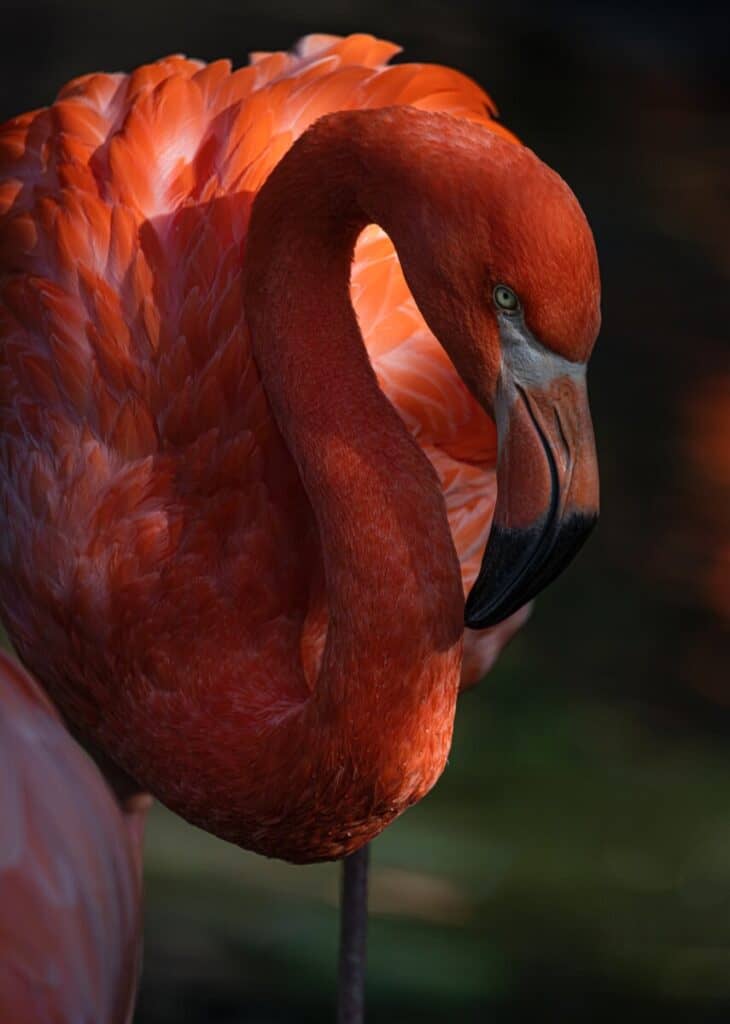
Brine shrimp are also pink…but not because they produce carotenoids themselves. They become pink when they feed on microscopic algae rich in the pigment. You can see that pink progresses up the food chain!
Without a rich enough diet of carotenoids, flamingos will lose some of their color. Zoos have to make a concerted effort to keep their flamingos pink by feeding them the appropriate foods.
When it comes to finding a mate, flamingos prefer pink…the pinker the better during courtship. Once they find a mate they remain monogamous for life and only produce one egg at a time. The flamingo nest is a strange-looking raised cup that the parents construct from mud.
You would think that flamingo chicks would be pink… but no, they are gray when they hatch and remain that color for 2-3 years. Newborn chicks are fed a red-colored ‘crop milk’ secreted from the upper digestive track of both parents. This rich diet is fed to the chicks for around 2 – 3 months. During this feeding period the parents fade in color!
Once the chick reaches 6 – 10 months of age, the plumage turns even darker gray and the beak and legs begin to turn pink. Slowly the entire bird begins to turn pink and by the time they reach sexual maturity at about age 6 years they are hopefully pink enough to attract a mate.
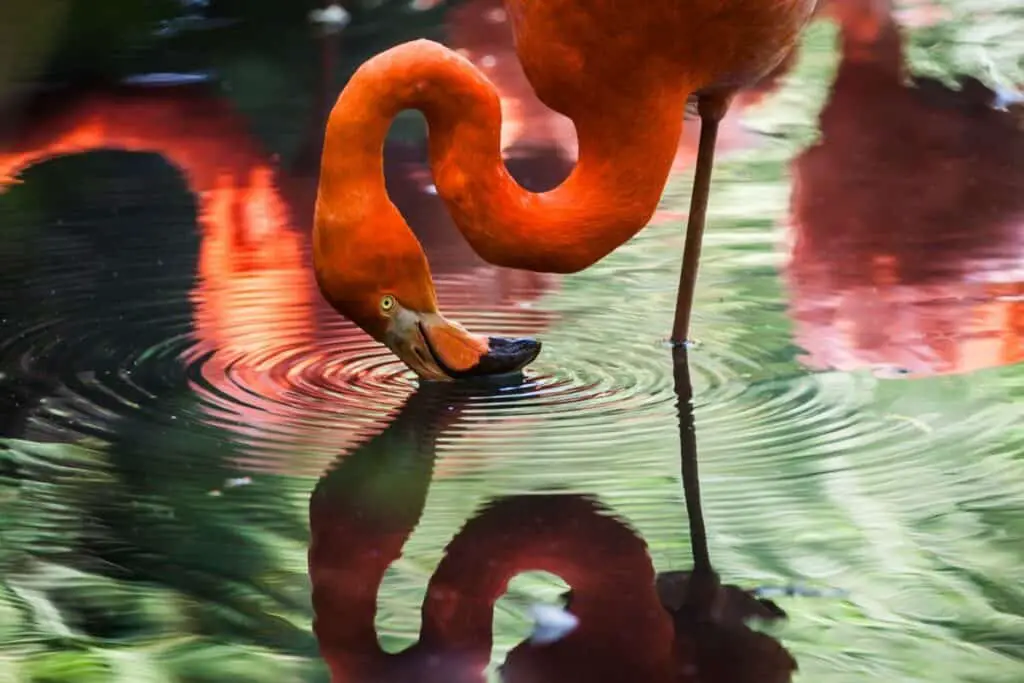
Photo by G. Cessati on Unsplash
And so it goes in the lives of flamingos… with curious beaks that are upside down and a devotion to becoming pink and staying pink. These birds can be long-lived – up to 70 years – so their pursuit of pink can last for many, many years.
Weird fact: people can begin to look orange if they eat too many carrots – carot-enoids!
The Gear We Love to Travel With
We love to travel in search of exceptional wildlife viewing opportunities and for life-enhancing cultural experiences.
Here is the gear we love to travel with for recording our adventures in safety and comfort:
- Action Camera: GoPro Hero10 Black – we find these waterproof cameras are invaluable for capturing the essence of our adventures in video format. Still photos are great, but video sequences with all the sights and sounds add an extra dimension. I use short video clips to spice up many of my audiovisual presentations.
- Long Zoom Camera: Panasonic LUMIX FZ300 Long Zoom Digital Camera – I love this camera for its versatility. It goes from wide angle to 28X optical in a relatively compact design. On safari in Africa I’ve managed to get good shots of lions that the folks with long lenses kept missing – because the lions were too close! I also like the 120 fps slow-motion for action shots of birds flying and animals on the move. I call this my “bird camera.”
- 360 Camera: Insta360 ONE R 360 – 5.7K 360 Degree Camera, Stabilization, Waterproof – see my article How to Take Impossible Shots with Your 360 Camera. This camera is literally like taking your own camera crew with you when you travel! Read my article and you’ll see why.
- Backpack camera mount: Peak Design Capture Clip
- Drone: DJI Mini 2 (Fly More Combo) – this mini drone is made for travel!
- Water Filtration: LifeStraw Go Water Filter Bottle
- Binoculars: Vortex Binoculars or Vortex Optics Diamondback HD Binoculars (good price)
Check Out Our TOP Articles for Even More Fascinating Creatures
- How do Octopus Reproduce? (Cannibalistic Sex, Detachable Penis)
- Do Jellyfish have Brains? How Can they Hunt without Brains?
- Why are Deep Sea Fish So Weird and Ugly? Warning: Scary Pictures!
- Are Komodo Dragons Dangerous? Where Can you See Them?
- Koala Brains – Why Being Dumb Can Be Smart (Natural Selection)
- Why do Lions Have Manes? (Do Dark Manes Mean More Sex?)
- How Do Lions Communicate? (Why Do Lions Roar?)
- How Dangerous are Stonefish? Can You Die if You Step on One?
- What Do Animals Do When They Hibernate? How do they Survive?
- Leaf Cutter Ants – Surprising Facts and Adaptations; Pictures and Videos
- Irukandji Jellyfish Facts and Adaptations; Can They Kill You? Are they spreading?
- How to See MORE Wildlife in the Amazon: 10 Practical Tips
- Is it Safe to go on Safari with Africa’s Top Predators and Most Dangerous Animals?
- What to Do if You Encounter a Bullet Ant? World’s Most Painful Stinging Insect!
- How Do Anglerfish Mate? Endless Sex or Die Trying!
- How Smart are Crocodiles? Can They Cooperate, Communicate…Use Tools?
- How Can We Save Our Oceans? With Marine Sanctuaries!
- Why Are Male Birds More Colorful? Ins and Outs of Sexual Selection Made Easy!
- Why is the Cassowary the Most Dangerous Bird in the World? 10 Facts
- How Do African Elephants Create Their Own Habitat?
- What is Killing Our Resident Orcas? Endangered Killer Whales
- Why are Animals of the Galapagos Islands Unique?
- Where Can You See Wild Lemurs in Madagascar? One of the Best Places
- Where Can You see Lyrebirds in the Wild? the Blue Mountains, Australia
- Keeping Mason Bees as Pets
- Why are Hippos Dangerous? (Do They Attack People?)

